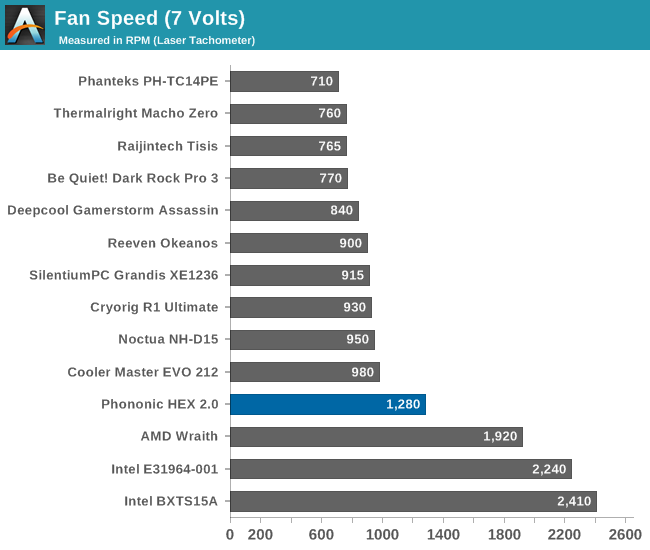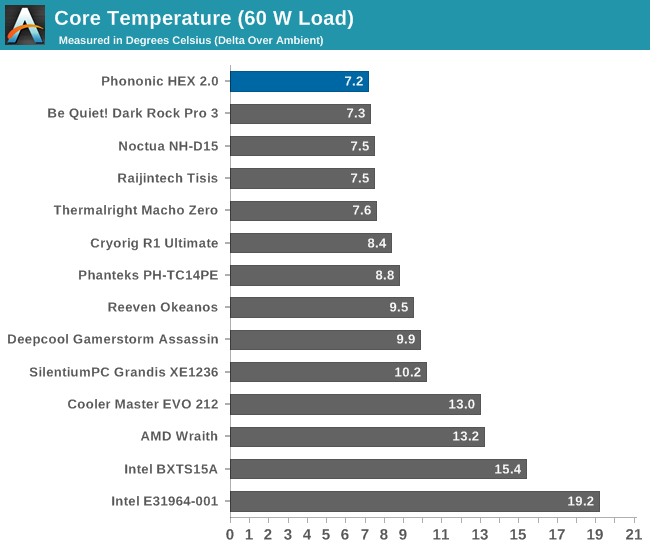The Phononic HEX 2.0 TEC CPU Cooler Review
by E. Fylladitakis on September 26, 2016 9:30 AM EST- Posted in
- Cases/Cooling/PSUs
- Cooler
- TEC
- Phononic
- HEX 2.0
Testing results, low fan speed (7 Volts)
Note that the voltage refers only to that of the fan, the TEC requires a constant 12V supply.


| Core Temperature, Constant Thermal Load (Low Fan Speed) |

The advantage of using a TEC at lower thermal loads becomes more apparent when the cooler fans are running at a reduced speed. Here we see that the performance of the HEX 2.0 was only slightly affected by the change of the fan’s speed under a thermal load of 60W, registering a thermal resistance of 0.1200 °C/W, a value comparable only to that of the best air coolers available. However, once again, the thermal performance of the HEX 2.0 degrades sharply as the thermal load increases, especially for thermal loads above 200W. With a thermal load of 340W, the thermal resistance of the HEX 2.0 is only 0.2506 °C/W, a very poor value that only outperforms low range and stock coolers.

In terms of acoustics performance, the 92 mm fan of the HEX 2.0 is virtually noiseless under these operating conditions. Our instruments recorded 33.6 dB(A) from a distance of one meter, only 3.2 dB(A) higher than our floor noise level. It will not be easily discernible by human ears inside a normal room, but it can be discerned if someone focus on the task.










48 Comments
View All Comments
DanNeely - Monday, September 26, 2016 - link
Do they have an plans to make a 120/140mm version and a larger TEC? The way this struggles above relatively low loads makes it a bust for the OC crowd who might otherwise be tempted to buy it.zepi - Monday, September 26, 2016 - link
Indeed, would be interesting to see this being bundled with NH-D15 level cooler.LordConrad - Tuesday, September 27, 2016 - link
I would also like to see the TEC with a better air cooler attached.saratoga4 - Monday, September 26, 2016 - link
Or one integrated into a watercooling setup. The main problem is that the TEC COP of performance is something like 1.0 to 1.5 watt of cooling per 1 watt of energy spent on the TEC, so you end up needing 1.5-2.0 watts of radiator for every watt of CPU heat generated. A dual 120 radiator ought to handle that easily.MrSpadge - Tuesday, September 27, 2016 - link
Chilled water with a phase change (refrigerator) cooler is way more efficient.JesseKramer - Wednesday, September 28, 2016 - link
Packaging would be more of an issue though I would think.There is lots of infrastructure set up around radiators inside cases.
Adding a TEC into an AIO could be a very interesting product
Lolimaster - Monday, September 26, 2016 - link
Nothing beast using air cooler and undervolting your cpu and maybe drop 100-300Mhz to maximize the gain. Do you really notice the tiny extra performance of OC while wasting tons of watts and heat?damianrobertjones - Monday, September 26, 2016 - link
Yes! I, as a child, often heard scary stories of the 'Nothing Beast'!AndrewJacksonZA - Monday, September 26, 2016 - link
*chuckle*Death666Angel - Tuesday, September 27, 2016 - link
I do. Running my 4770k @ ~3.4GHz like you suggest vs. the 4.5GHz it currently runs at would not save much energy on normal tasks (I OC with an adaptive offset, so 800MHz use ~ 0.71V). Even in many modern games (The Witcher 3, Battlefield 4), I would get lower FPS with such a CPU clock and my R9 290X, which is more CPU dependant than typical Nvidia graphics cards. And doing video encoding of my Blu Ray rips would be painfully slow, scaling nearly linearly with clockspeed. The ~50 to 90W I spend more on intensive tasks is worth it for me, since I can saturate 110FPS with my monitor @ 110Hz and save time during encoding (which make total power consumption per rip not as bad as it would seem).